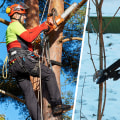Tree pruning is an important part of tree care, and the best time to prune trees and shrubs is during the winter months. This is because trees are dormant in cold weather, making it easier to visualize the structure of the branches. Pruning in late winter and early spring helps trees focus their energy on producing healthy new growth once the climate warms up. Contrary to popular belief, pruning trees in autumn can be damaging or even deadly for mature trees.
For most tree species, pruning in spring can give good results. Early spring makes it possible to easily identify problem branches before the tree has completely defoliated. Light summer pruning can be done on most deciduous trees and shrubs, but a more intensive pruning should be carried out when the tree is inactive, preferably in late winter or early spring. Trees such as maples (Acer) should be pruned in winter while trees are dormant, while shrubs that bloom in spring, such as lilac and forsythia, should be pruned within two weeks after flowering.
In general, the ideal window for pruning is between late autumn and early spring, after the leaves fall and before the flowers appear. There is never a bad time to remove dead, damaged or diseased branches. But most trees benefit from pruning in the middle or late winter. Pruning during dormancy encourages new growth as soon as the weather starts to warm up.
The lack of leaves after autumn allows you to easily identify branches and branches that require removal. When pruning trees, it's important to thin out the crown so that the tree looks completely unpruned. You only need to remove 10 to 20 percent of tree branches from the edge of the canopy. Large trees benefit from removing end parts of branches between 1 and 4 inches in diameter, while small ornamental and fruit trees can be thinned by removing smaller branches between ¼ and ½ inch thick.
The best time to prune limbs is late winter or early spring. This allows maximum wound closure during the growing season and reduction of disease transmission. Keep in mind that some tree species have a habit of bleeding when the sap rises in early spring and pruning would be better done at another time (i.e., late winter). The pruning cycle of a tree is usually 3-5 years, but this will depend on the species, size and health of your tree. Pruning trees in winter encourages new growth in spring, but it's best to do it after the coldest part of the season to prevent all three from being vulnerable to extreme cold waves.
To avoid hurting a tree with thin flow, take advantage of these months of inactivity to develop a plan for pruning and trimming trees in your landscaping. Tree branches are pruned for multiple reasons, all of which result in a better-looking, better-yielding tree. Cleaning the crown of the tree strengthens the overall tree and prevents future damage to both the tree and the surrounding property, while increasing the overall safety of your landscaping. For shorter trees, look for tree clippers with long reach poles so you can keep your own feet safely on the ground. For larger established shade trees, leave it to qualified arborists and tree care professionals. Qualified tree care specialists are pruning trees every day throughout the year without many detrimental effects. Pruning certain tree species in summer helps you avoid the sticky mess you might experience with these species at other times of the year.
Cuts take longer to heal during this period of time because the tree goes into dormancy and when trees with fungal diseases release large amounts of spores after being cut, there is an increased risk of infection from released spores. By pruning and pruning trees in specific ways, you can encourage fruiting and flowering, shape plants into specific shapes, and control plant size.


